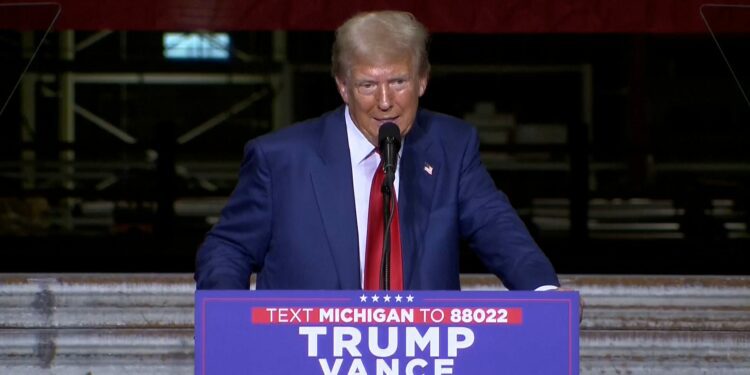4-minute read
Trump denies Arlington cemetery photos were campaign stunt
Trump election staffers reportedly clashed with an Arlington National Cemetery official who tried to stop their photography.
To walk across Arlington National Cemetery is to walk amid memories. You need to tread lightly.
I know. My mother and father are buried at Arlington.
But what does Donald Trump understand about America’s most famous and most hallowed graveyard? America should wonder.
Section 11 — the site of my parents’ graves — sits on a leafy hill, about a half-mile from Section 60, where many service members who died in Iraq or Afghanistan have been laid to rest. Trump visited Section 60, reportedly at the invitation of relatives of U.S. Marines laid to rest there after they were killed by a suicide bomber in Afghanistan during the Pentagon’s mistake-filled pullout from that war zone in 2021.
Cemetery officials rebuked Trump for breaking the rules and turning his visit into a campaign photo-op, posing thumbs-up and smiling as if he were at one of his rallies — or, worse, a back-yard meet-and-greet with voters. Trump, of course, claims he did nothing wrong. But to understand the enormity of how Trump disgraced Arlington and those buried there, you need to go there.
What do you experience at Arlington National Cemetery?
What you see are not just the rows of identical tombstones that are, in themselves, so haunting. Each tombstone can tell a story. But Arlington is not some sort of hall of fame. Nor is it a make-believe theme park. It’s the final resting place of thousands of people who sacrificed in some way for their country. In other words, they offered themselves for something other than their own self-interest. That’s the essence of the story Trump seems to miss.
Each grave tells us the rank and service of the person buried there. Some tombstones add that the deceased served during a war. Some make note of medals that were awarded.
My father’s tombstone tells us that he served in three wars — World War II, Korea and Vietnam — as a U.S. Marine, rising from an 18-year-old private to retiring as a major in his 50s. His tombstone also tells you that his many medals included a Silver Star for gallantry and a Purple Heart for being wounded. In my mother’s case, you can decipher that she enlisted as a 19-year-old in the then-brand-new women’s component of the U.S. Marines. Her tombstone says she served during World War II and Korea with the Marines, retiring as a sergeant.
Such basic information is just a starting point, however. From such rudimentary tombstone facts, there is often a far deeper story of service and courage.
My father’s tombstone does not tell you that he was awarded a Silver Star for leading an attack on a Japanese-held pillbox on a forgotten Pacific island on Christmas Day 1943. A few months before, he turned 20. And, at that point, he had already survived the rugged campaign of Guadalcanal and a bout with malaria. He received a Purple Heart after surviving an explosion in an attack in Saigon in 1966.
My mother’s tombstone does not say she was a member of one of the first classes of women Marines to endure the Corps’ famous (infamous?) boot camp. She later worked in what was then a new government building called the Pentagon. After World War II, she was one of 100 women Marines asked to stay on in the service as an experiment on how the Marines might incorporate women. She had to leave, in the final days of the Korean conflict, when she married my father and became pregnant with me. Back then, pregnant women were not allowed to remain in the U.S. military. In my mother’s later years, she campaigned for the rights of women to remain in the service when they became pregnant. One of those women — a retired Marine lieutenant colonel — became one of her best friends in her elder years and was at Arlington for my mother’s burial two years ago with the son she raised during her military career.
That is just a hint of the kinds of stories you find at Arlington. Here is another:
A few feet from my parents’ graves is the resting place of a 20-something U.S. Army Air Corps lieutenant, killed in France in 1943. What that brief description tells you is that this young man was either a pilot or a crew member of a fighter or bomber flying over Nazi-occupied France during World War II.
But then, when you notice the Star of David on the tombstone and the man’s Jewish surname, you can’t help but sense the deep courage that he surely possessed, in volunteering as a Jew to fly over a terrain where he would have likely been tortured and executed by the Nazis if he had been shot down and captured.
In another sense, consider the stories associated with the memorial to the Kennedy family. There is the much-visited hillside portico that is home to the “eternal flame” that burns over the grave of President John F. Kennedy, his wife, Jacqueline, and their two infants who died. Nearby, on lush grass, sit simple white crosses — one for Kennedy’s assassinated brother, Robert, another for his brother Edward, the veteran U.S. Senator from Massachusetts.
A few steps beyond those graves, however, is another white cross that is easy to overlook. This one is for Kennedy’s older brother, Joseph, a U.S. Navy pilot. But this cross tells you that the site is only a memorial. No remains are buried there. Joseph was shot down in 1943 while piloting a B-24 bomber on a secret mission over the English Channel. His body was never recovered. All that remains is that white cross.
That kind of memorial is not unusual in Arlington. In fact, on just about any hillside — especially in spots unsuitable for graves — you can find memorials to soldiers whose bodies were never recovered from a battlefield.
Or you can find other graves that tell a different sort of tragedy.
For instance, on a hill not far from the Tomb of the Unknown Soldier is the grave of Charles Burlingame, a U.S. Navy pilot who flew missions in Vietnam and during the first Persian Gulf War and later became a commercial airline pilot. Burlingame was killed by al-Qaida terrorists on Sept. 11, 2001, just before they took control of his jetliner, American Airlines Flight 77, and crashed it into the Pentagon.
Just a short walk southward from Burlingame’s grave is the bowl-like meadow that is home to the graves of dozens of women — most of them nurses — killed in war zones. To the north sits a memorial to Pan Am Flight 103, the jetliner blown out of the sky over Lockerbie, Scotland, when a bomb planted by Libyan terrorists exploded just before Christmas 1988, killing 270 people.
Elsewhere, you can find a mass grave for the 250 Coast Guard sailors, Army soldiers and medical personnel who were killed when a ship blew up in the Solomon Islands during World War II. The bodies were so mangled that they were placed in just 52 coffins — a reminder of the brutality of war.
More Mike Kelly: A gala for Jan. 6 rioters at Trump’s NJ golf club? Who is he kidding?
Does Donald Trump actually care about our military?
Did Trump know any of this history when he tramped through Arlington National Cemetery two weeks ago with his campaign film crew? Did his staff have any clue about the site’s history as they pushed aside a cemetery worker who tried to tell them that campaign events were prohibited?
Did Trump even think to apologize? To accept some measure of responsibility for what he did?
I have wondered for nearly a decade why Trump’s followers, while sometimes criticizing his habit of attacking anyone he perceives as a rival, nonetheless give him a pass when he insults the military. Here, Trump’s record is shameful.
In 2015, he described Sen. John McCain, who survived five years in a North Vietnamese prison camp, as “not a war hero.”
Said Trump: “I like people who weren’t captured.”
McCain’s son, James, a U.S. Army 1st lieutenant, stepped forward this week to not only condemn Trump’s visit to Arlington National Cemetery but to announce that he was leaving the Republican Party because of his distaste for the former president and that he plans to join the Democratic Party and vote for Democratic presidential nominee Kamala Harris.
Months after brandishing John McCain as “not a war hero,” Trump criticized the parents of a U.S. Army captain killed in Iraq, who happened to be Muslim, because they spoke at the Democratic National Convention that nominated Hillary Clinton.
Later, as president, he told his chief of staff that he did not want wounded veterans at a ceremony because it doesn’t “look good for me.”
Later still, he told the widow of a U.S. soldier, killed on a mission in Africa, that he “knew what he signed up for.” And just before losing the presidency in 2020, he surmised that veterans and their families visiting the White House might have infected him with COVID-19.
Also as president, he reportedly canceled a visit to a U.S. military cemetery in France because he did not want to mess up his hair and referred to the cemetery as “filled with losers.”
Only weeks ago, in one of Trump’s more inexplicable and indecipherable statements, he described the civilian Medal of Freedom as “actually much better” than the military’s Medal of Honor. Said Trump: “Everyone gets the Congressional Medal of Honor, that’s soldiers, they’re either in very bad shape because they’ve been hit so many times by bullets, or they’re dead.”
What kind of person, who has spent even a few minutes around soldiers, as a president should, or who bothers to read even a paragraph or two of history, speaks like that?
Such are just a few of the stories of Trump. Is anyone shocked that this is the same man who traipsed through Arlington National Cemetery in recent weeks with a campaign film crew?
Yes, he offered the excuse that he had been invited by families of U.S. Marines and others killed by a suicide bomb in Afghanistan. And yes, he made a point of unfairly and gratuitously blaming President Joe Biden for the botched evacuation of the U.S. military from Afghanistan.
But Trump missed something very basic.
He missed the ground he stepped on.
Mike Kelly is an award-winning columnist for NorthJersey.com, part of the USA TODAY Network, as well as the author of three critically acclaimed nonfiction books and a podcast and documentary film producer. A paperback edition with an updated epilogue of his 1995 book, “Color Lines,” which chronicles race relations in a small New Jersey town after a police shooting and was called “American journalism at its best” by the Washington Post, was released last year. To get unlimited access to his insightful thoughts on how we live life in the Northeast, please subscribe or activate your digital account today.
Email: [email protected]
Source link : https://www.usatoday.com/story/opinion/columnists/mike-kelly/2024/09/05/donald-trump-doesnt-understand-arlington-national-cemetery/75063591007/
Author :
Publish date : 2024-09-04 21:28:00
Copyright for syndicated content belongs to the linked Source.






